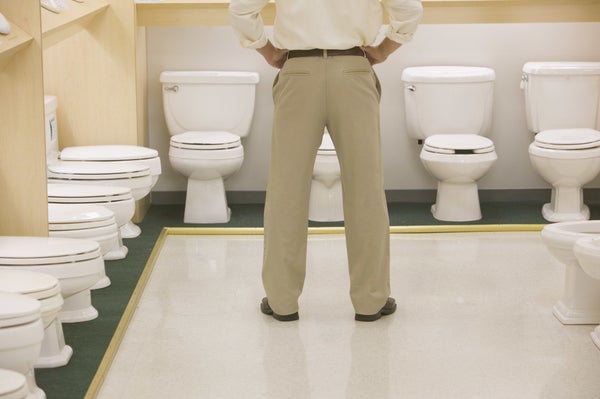This article was published in Scientific American’s former blog network and reflects the views of the author, not necessarily those of Scientific American
As the American public fiercely debates access to and the policing of the use of public bathroom facilities, an estimated 946 million people are still practicing open defecation. And 2.4 billion are using facilities that do not ensure the hygienic separation of fecal matter from human contact. How do they go? They’re using buckets or uncovered pits or hanging latrines. This is a global sanitation and health concern as the spread of fecal contaminants can lead to debilitating illnesses, particularly in children (but women and other underserved populations are also at risk). For these people, shared facilities may be key.
Shared bathrooms in this context refers to two or more families using a communal facility and sharing responsibility for its upkeep (or having that upkeep managed by a governing body). Shared bathrooms are preferential to open defecation as the latter increases the likelihood of fecal contamination. Frequent exposure to fecally contaminated food, water, human hands, soil and other infected items can lead to acute diarrhea and gut infections, particularly in children. Intestinal pathogens are allegedly tied to 1.7 billion episodes of diarrhea in children younger than 5 every year. And of this number 10%-15% will die from intestinal infections. But that’s not all: chronic diarrhea, as is a likely occurrence in these contexts, can also result malnutrition and growth stunting. Basic improvements in hygiene, like hand washing, can greatly impact this number. But access to a bathroom or sanitation facility, which removes contact with human waste, can reduce the risk of diarrhea up to 36%.
According to WHO/UNICEF, improved bathroom facilities are those the hygienically separate human waste from human contact. This includes facilities that include a flush or pour-flush toilet/latrine to a piped sewer or septic system, a pit latrine, a ventilated pit latrine, a pit latrine with a slab, or a composting toilet. To bring improved sanitation options to communities in need, people must either be given the means to build their own facilities or the government must provide them. In the former case, these facilities may be co-owned, or shared, between a few households. The perceived hierarchy of desirability when it comes to bathrooms in this case is such: open defecation < government-run facilities < shared household facilities < private, single family facilities.
On supporting science journalism
If you're enjoying this article, consider supporting our award-winning journalism by subscribing. By purchasing a subscription you are helping to ensure the future of impactful stories about the discoveries and ideas shaping our world today.
It was previously believed that shared, household facilities might be cleaner and better maintained because the owners had a relationship with each other, as compared to government facilities where strangers are sharing a bathroom and the cleaning is managed by an outside entity. But researchers found that children in households that shared a latrine with neighbors were more likely to experience diarrhea and other intestinal issues than children in other bathroom contexts, except for those who practiced open defecation. One possible explanation for this is that the cleaning of government-run facilities is managed by a third party who is being paid for the task. And the facilities themselves may need to meet certain health codes and standards. Whereas in the private, family-owned scenario, families may put off cleaning the site while they assume someone else will do it. As the facility deteriorates, people may be less likely to use these options and pick up pathogens from the surrounding areas as they relieve themselves in alternative spaces or use unclean bathrooms. As a result of these findings, WHO/UNICEF has tended to list shared facilities as “unimproved,” meaning that they do not sufficiently provide the hygienic and comfort improvements needed to combat the spread of disease.
A blanket assignment here has been recognized by various researchers as a disservice to people in need. The most desired option, of course, is a private facility, but where this isn’t possible shared bathrooms can provide significant changes for communities. Open defecation requires finding a private space that is relatively comfortable for the individual. It leaves the individual open to attack, harassment or interruption. Globally, the poorest people are the ones who struggle with these basic aspects of access and sanitation. Women and children, who are most in need of safe, clean spaces for defecation and infant bathing, stand to benefit the most from shared spaces and are most likely to use these spaces. Increasing comfort and satisfaction with bathroom facilities, achieved by encouraging hygienic practices which may translate into cleaner facilities, may help encourage use.
Having a dedicated space to pass human waste is a social luxury. In the absence of a such a space, shared facilities may be the best option. Undoubtedly, even in these limited circumstances, there may be people who are barred from these facilities. But the alternative of driving them to open defecation seems to hurt everyone.
--
Cited
Baker KK, O’Reilly CE, Levine MM, Kotloff KL, Nataro JP, et al. (2016) Sanitation and Hygiene-Specific Risk Factors for Moderate-to-Severe Diarrhea in Young Children in the Global Enteric Multicenter Study, 2007–2011: Case-Control Study. PLoS Med 13(5): e1002010. doi: 10.1371/journal.pmed.1002010
Nelson KB, Karver J, Kullman C, Graham JP (2014) User Perceptions of Shared Sanitation among Rural Households in Indonesia and Bangladesh. PLoS ONE 9(8): e103886. doi: 10.1371/journal.pone.0103886
--
You may also like:
Sanitation and the Rise of New York City’s Water Towers
